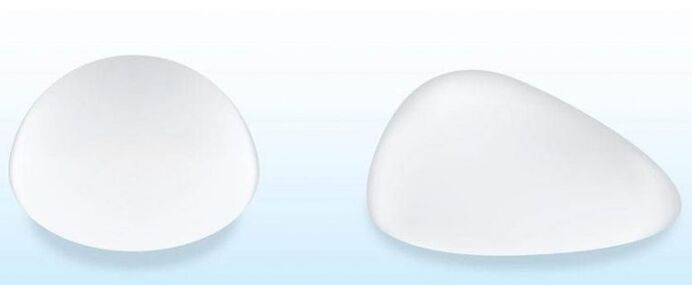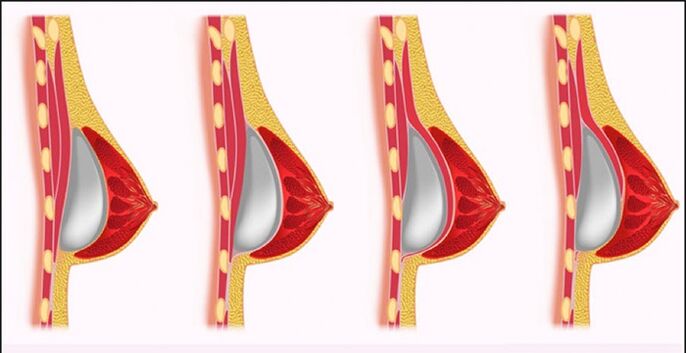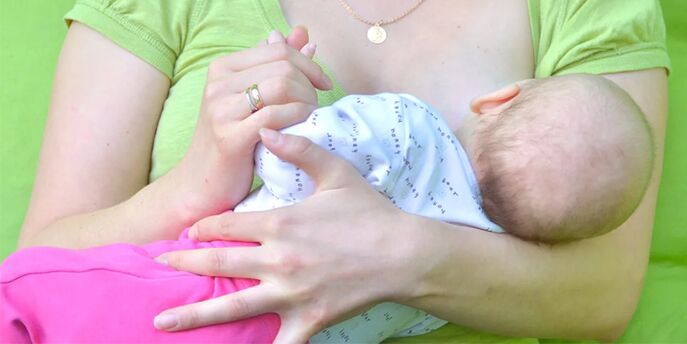Shape correction, breast augmentation is one of the most popular plastic surgery procedures. With the help of mammoplasty, you can correct congenital or acquired defects of the breast, restore its volume, elasticity after childbirth and breastfeeding. Proper surgery helps a woman become more attractive, more confident in herself.
Indications for surgery
- Descent and reduced elasticity of the mammary glands (mastoplasty).
- Increased breast volume while maintaining its tone and position (macropathy).
- Reduction of the mammary glands after breastfeeding.
- Small breast size (micromastia).
- Enlarged breast tumor in men (gynecomastia).
Types of mammoplasty
- Augmentation mammoplasty(endoprosthesis) - breast augmentation, correction of its shape using implants. Used after childbirth, breastfeeding, with congenital asymmetry.
- Reduction mastoplasty- Reduction of the size of the bust with mastopathy or macropathy.
- Mastopexy- breast augmentation. Suitable for breast augmentation, if the breast tumor meets the requirements for surgery.
Endoprosthesis of the mammary glands
The operation involves the installation of silicone prostheses (implants) in the mammary glands. The choice of the point of intersection is in accordance with the woman. The implant is placed under the pectoralis muscle and, if breast volume allows, between the muscle and the mammary gland. The incision is sewn, no drainage is required. The nipple and areola are enlarged after surgery.
Breast implants
Silicone or polyurethane stents correct the volume, the shape of the bust, give a feeling of natural tissues of the body.
The lifespan of implants exceeds 15 years, after which their replacement is recommended.

The products differ in various indicators:
- Supplements: cohesive gels or saline (sodium chloride). The composition of the gels is more elastic, homogeneous, light, but dangerous for the body in case of leakage. The salt solution is safer, softer, cheaper. Negative properties - gargle when moving, prone to leakage.
- Structure: rough (textured) or smooth. Textured implants are more stable, but skin folds can be caused by the rubbing of body tissues on their surface. The disadvantage of smooth dentures is the possibility of displacement.
- Shape: anatomical or round. The former have a more natural appearance, while the latter retain the symmetry and shape of the chest even when displaced.
Reduction mastoplasty
During this type of surgery, the fatty tissue and breast tissue are partially removed, resized and given a new shape.
Removing excess tissue reduces the chance of cancer.
Breast reduction options:
- Liposuction The method is considered conservative and leaves no seams. Designed for small breast reduction with mild degrees of mastoplasty.
- Short (vertical) seam. A popular method in which the breasts retain their natural shape and the nipples are sensitive. The operation takes a short time and the complication rate is low.
- T-shaped cut (anchor). The classic method, which is used for large amounts of tissue to be removed. Its disadvantages are the duration of recovery, a large scar.
- Amputation with nipple transfer. Used for very large breasts. The method is associated with a high risk of mammary gland injury, loss of nipple sensitivity and inability to breastfeed.
Mastopexy
Breast augmentation without implants is possible in several ways:
- The vertical is used for breastfeeding 1-2 degrees, the seams are almost invisible, the cosmetic effect is long lasting. The method is ineffective for reducing the breast by 3-4 degrees.
- Anchor mastopexy gives good results for falls of any complexity. Disadvantages include a longer recovery period, noticeable sutures, increased risk of breast tissue injury.
- Peripheral mastopexy is the removal of a small piece of skin around the cannula. Suitable for hypoplasia, for other forms of bust relaxation is ineffective.
Operating stages
For an excellent result of plastic surgery, high quality medical care in all 3 stages is important. The preparatory period lasts 1-2 weeks. The actual surgery lasts from 1 to 4 hours.
Complete recovery takes place within 1. 5 months.
Preparation for mammoplasty

The operation is performed no earlier than one year after the end of breastfeeding. 2 weeks before surgery, it is forbidden to take hormonal contraceptives, aspirin and preparations containing salicylates.
You should stop drinking alcohol, smoking.
During the preparation, the research must be carried out:
- general and biochemical blood tests;
- electrocardiogram;
- blood test for anticoagulants (coagulation)
- Ultrasound of the mammary glands.
- general urine analysis
- tests for hepatitis and HIV.
The course of surgery

Breast augmentation is performed under general anesthesia. A special type is the extension of the dermatology. It is used to increase breast volume with a lack of its own tissue and large implant sizes. The process takes place in 2 stages. First, an expander is installed to gradually stretch the breast tissue for 1, 5-2 months.
When the desired size is reached, a stent is placed in the chest.
Intersection operation methods:
- Through the fold under the chest (submassive access). Safe method for augmentation mammoplasty. A scar from a 4-5 cm long incision disappears over time under a slightly lowered chest. Access is difficult with small breasts in thin girls.
- An incision around or along the lower arch of the areola (perihelion approach). Advantage - surgical scars are almost invisible. For patients planning to breastfeed, this method is not recommended due to the high risk of breast injury.
- Endoscopic growth through the axillary approach. High-tech equipment helps to implant the implant without damaging blood vessels and nerve fibers. A 3-4 cm long incision is made in the axillary zone and then the scar is naturally covered. There is a limit to the volume of the implant - up to 400 ml.
- Endoscopic access through the navel. This method is rarely used due to the distance of the entry point from the point of operation, the difficulties with the formation of a "pocket" for the prosthesis.
Rehabilitation after mammoplasty

If the operation was performed without complications, the patient remains in the hospital for up to 3 days. After discharge, it is necessary to watch bandages. Moderate pain in the area of intervention that occurs in the first days is considered natural. Feelings of tightness of the skin are possible due to postoperative edema, which subsides after about 5-7 days.
After 4-6 weeks, the breast relaxes slightly, looks more natural and capsules form around the implants.
Rules for successful recovery:
- Do not load the shoulder belt, do not lift weights.
- Do not visit gyms, swimming pools, saunas, baths.
- Sleep on your back.
- Do not raise your hands.
- After breast augmentation, be sure to wear compression garments.
Possible complications
- Capsic contraction. The body forms a shell around the stent, which can lead to its displacement, violation of the symmetry of the mammary glands and their hardening.
- Contamination. Infection occurs during operation due to violation of aseptic rules or after non-compliance with antiseptic treatment standards. The period of particular risk is 1 week after surgery.
- Keloid, hypertrophic scars. They appear if the body has a predisposition for their formation. The formations look like dense ridges that rise above the surface of the skin and spoil the appearance of the breast.
- Accumulation of blood, serous fluid (hematoma, serum) and, as a result, dark skin color. Occurs when blood vessels, lymph vessels have been damaged during surgery or during the recovery period. The complication occurs due to low blood clotting, sudden increases in blood pressure, incorrectly sized stent.
- Decreased or lost sensitivity of the nipples, areola. It often occurs when large breasts shrink with a reduction in mastoplasty due to nerve damage.
- Implant rupture. It appears due to the thin shell, which is often found in inexpensive additions. The filler salt is easily absorbed by the body without causing harm. Damage to an stent with a cohesive gel is not always noticeable, but it is dangerous if the silicone penetrates the tissues of the body.
Breastfeeding after surgery

The safest operation is through an incision in the armpit (transaxillary) or under the breast (submammary).
About one year after surgery, breastfeeding is allowed.
Breastfeeding problems can occur in the following cases:
- The stent is placed so that it compresses the mammary glands, reducing the volume of milk they produce.
- An incision along the areola is more likely to injure the nerve endings around the nipple.
- The reduction plastic, which is associated with the reduction of breast size, disrupts the milk ducts, impedes their functions.
In which cases is breast plastic surgery contraindicated?
- Cardiovascular diseases, varicose veins (thrombophlebitis, thrombosis).
- Severe forms of mastopathy.
- Oncology.
- Blood clotting disorders, diabetes mellitus.
- Infectious diseases (ARVI, influenza).
- Neurological, mental disorders.
- Pregnancy, breastfeeding.
- Age under 18 years.
Advantages and disadvantages of mammoplasty

Advantages of plastic breast correction:
- Implementation of modern interventions.
- Correction of congenital and acquired defects of the mammary glands.
- Long lasting and intense aesthetic result.
- Short operating conditions.
- The possibility of choosing the shape, the material of the stents at will.
- Maintaining breastfeeding ability.
Possible disadvantages include:
- Skin marks from incisions - sutures, scars (unless special absorbent materials were used).
- Threat of complications (infection, breast deformity, bleeding).
- The need to change stents every 10-15 years.
- The high cost of breast augmentation.
- The need for general anesthesia.
- Painful sensations in the first postoperative days.
- The need to constantly wear compression underwear.
- A long period of recovery (from several months to a year) with the denial of sports, physical activity, pregnancy, breastfeeding.


























